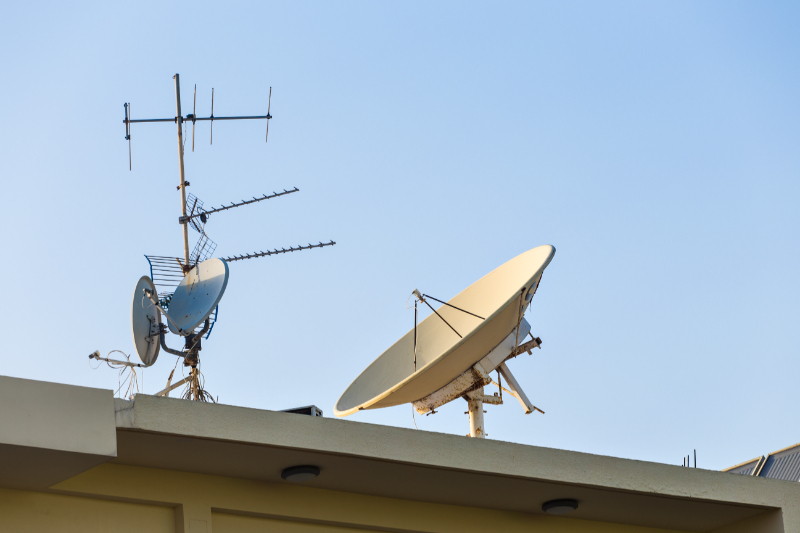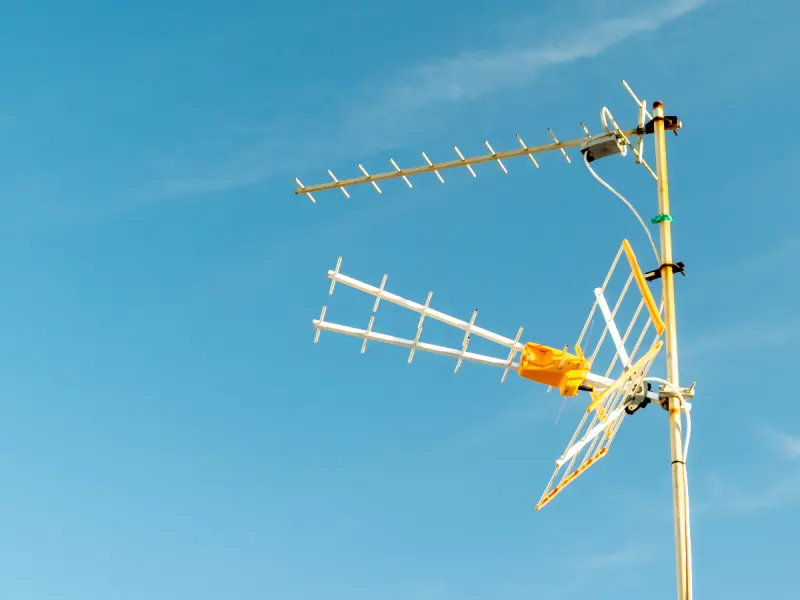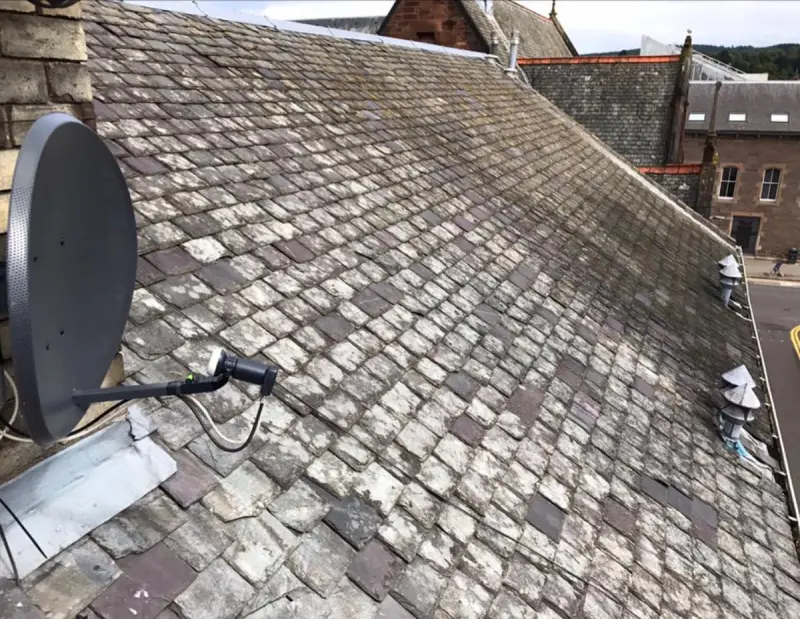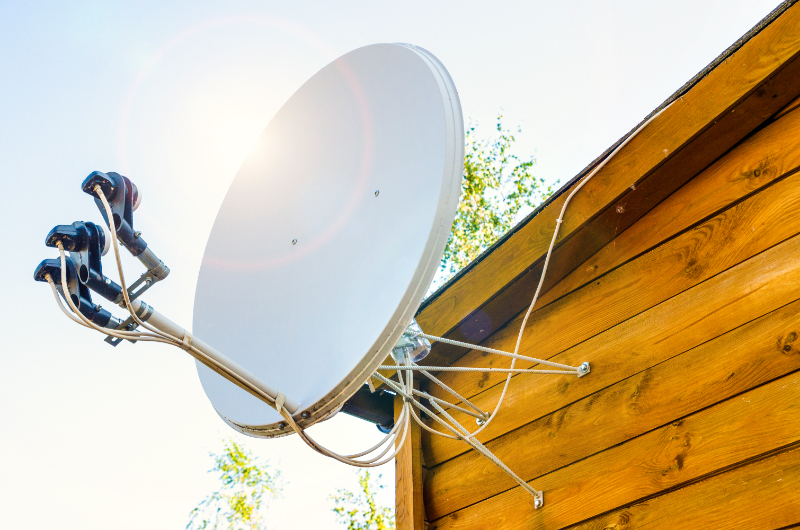When do you need an aerial installation? We look at the many reasons why your property will need an upgrade for your aerial system. Fair City Aerial & Digital TV Services offer satellite & TV aerial installation throughout Perth, Perthshire and Tayside.
TV Aerial Or Satellite Dish?
Navigating between a TV aerial and a satellite dish for your television signal can be perplexing, given the conflicting opinions.
Some vouch for the reliability of TV aerials, while others lean toward satellite dishes for superior reception. In this guide, we aim to demystify the dilemma, equipping you with the knowledge to make an informed decision that suits your circumstances.
The question of what each option offers is still debated. Contrary to misconceptions, TV aerials have regained popularity recently, and satellite choices like Freesat don't entail monthly fees. A crucial aspect of the decision-making process is the cost involved.
For those prioritising free services and financial prudence, expenses play a vital role. However, there's no universal answer as costs depend on specific situations. A satellite dish installation can sometimes be more affordable due to its simpler setup, though the added expense of a satellite receiver could offset this advantage.
In typical scenarios, setting up a satellite dish is less complicated, with costs akin to TV aerial installations. A standard installation of a mini-dish on a south-facing wall and a 15-meter cable is usually more cost-effective than placing an aerial on a roof. Yet, satellite TV often becomes costlier due to the receiver's price.
To illustrate, Smart Aerials charges approximately £185-£195 inc VAT for a new TV aerial installation, while a new satellite dish setup plus a Humax Freesat Box costs around £254.
Ultimately, the choice rests on your budget, viewing preferences, and equipment. By understanding costs, benefits, and available options, you'll confidently select between a TV aerial or satellite dish, tailored to your entertainment needs and circumstances.
Common Reasons For Needing An Aerial Installation
There are several common scenarios that might prompt you to consider the necessity of an aerial installation, whether you're just settling into a new home or dealing with the challenge of multiple TVs within your living space.
In both cases, an aerial installation can play a pivotal role in enhancing your TV viewing experience, ensuring seamless entertainment across all screens.
The excitement of moving into a new residence comes with a flurry of tasks. Amidst the chaos, setting up a TV aerial might not initially be at the forefront of your mind. However, taking the time to arrange an aerial installation early on can be a productive way to keep yourself engaged during the settling-in process.

Aerial TV installation is a relatively swift procedure, making it feasible to have it done before you fully establish your new home. By ensuring a reliable signal from the outset, you can enjoy uninterrupted entertainment as you make your new space truly feel like your own. With the prevalence of multiple TVs in modern households, ensuring each screen receives a quality signal is crucial.
TV aerials offer a solution by enabling you to split the signal and distribute it to various televisions throughout your home. Employing a splitter facilitates the seamless sharing of the aerial feed, granting each member of the household access to their preferred programming. This not only promotes harmony in entertainment choices but also eliminates the need for individual installations for each TV, saving both time and installation costs.
You Live Somewhere With Bad Weather
Residing in a region with inclement weather can impact various aspects of daily life, including your TV signal quality. In such situations, a robust and weather-resistant TV aerial installation is essential. Learn how choosing wisely can ensure uninterrupted entertainment even in adverse conditions. Outdoor digital TV aerials are engineered to provide faultless reception over distances of up to 30 miles from the broadcast transmitter. These aerials are built to endure harsh weather, from heavy snowstorms to strong winds.
Properly installed, your TV aerial will maintain a steady connection to your favourite shows. Properties have diverse needs, and TV aerials offer various options to suit signal requirements. Whether in urban or rural areas, our range accommodates different signals, guaranteeing optimal reception no matter your location.
By combining sturdy construction, advanced technology, and versatile compatibility, outdoor TV aerials promise optimal reception today and in the future. Don't let the weather compromise your viewing pleasure. Invest in an outdoor TV aerial that withstands the elements, delivering exceptional entertainment regardless of weather challenges.
You Need Access To Freeview
When it comes to enjoying Freeview, having a reliable TV aerial is paramount. To access Freeview's live TV offerings through the TV Guide, a functional aerial is a necessity. Certain Freeview channels can even be accessed on internet-connected devices, offering flexibility in your viewing experience.For those already equipped with an aerial, ensuring the cables are intact and properly connected to your home's aerial point is crucial. The aerial itself should be securely plugged into the socket at the rear of your Freeview TV or recorder.
A robust aerial connection guarantees uninterrupted signal flow for seamless content enjoyment. However, proper setup is only part of the equation. The positioning and condition of your aerial matter significantly. Correct alignment is essential for optimal signal quality. Regular checks are advised to ensure it's pointing in the same direction as nearby aerials. Additionally, safeguarding the aerial against weather-related damage is vital to maintain consistent reception.

Antennas For Bad Weather

Antennas For Freeview
Are TV Aerials Obsolete?
The question of whether TV aerials are obsolete carries a nuanced answer. In a landscape enriched by various media delivery mechanisms, TV aerials have pivoted from being the primary and sole source of television content to coexisting alongside newer technologies. They remain a crucial link to free-to-air broadcasts, catering to those who value a diverse range of programming and wish to avoid subscription-based models.
As technological progress continues, TV aerials have demonstrated their capacity to evolve and accommodate emerging standards, firmly asserting their place in the modern entertainment ecosystem. Rather than fading into the annals of history, TV aerials have demonstrated resilience and adaptability, standing as a testament to the enduring relevance of tried-and-true technology in an ever-changing world. In the ever-evolving realm of entertainment technology, the status of TV aerials, those iconic antennas perched atop our roofs, has come under scrutiny.
As the landscape shifts towards digital streaming and satellite broadcasting, it's natural to wonder whether traditional TV aerials are still relevant or if they've succumbed to obsolescence. Let's delve into this matter and explore the role of TV aerials in today's media-saturated world.
Evolution of Broadcasting
For decades, TV aerials have served as conduits to terrestrial broadcasts, allowing households to access a spectrum of free-to-air channels. However, as technology advances and viewing habits transform, the role of TV aerials has undergone a metamorphosis. Cable, satellite, and internet streaming services have expanded the options available to viewers, introducing more flexibility in what, when, and how we watch.
The Digital Revolution
The transition from analogue to digital broadcasting marked a pivotal juncture in television history. Digital signals brought about improved picture quality, additional channels, and a more immersive viewing experience. This shift necessitated the upgrade of existing aerials to ensure compatibility with the new standard. This adaptability demonstrated that TV aerials could evolve alongside technological advancements, defying the notion of obsolescence.
Navigating the Digital Divide
While alternatives have emerged, TV aerials continue to play a critical role in bridging the gap between viewers and free-to-air broadcasts. Particularly for those who opt out of subscription-based services or reside in regions with limited internet connectivity, TV aerials are a lifeline, ensuring access to news, entertainment, and information.
Complementary Technology
Rather than being overshadowed by new entrants, TV aerials have found a niche as a complementary technology. They coexist harmoniously with satellite dishes, cable TV, and streaming services, offering a comprehensive array of options to cater to diverse preferences. In areas where satellite coverage might be weak or absent, TV aerials maintain their value, providing reliable access to a multitude of channels.
Future-proofing with Adaptability
As technology propels broadcasting into new dimensions, TV aerials exhibit remarkable adaptability. The arrival of high-definition (HD) and ultra-high-definition (4K) broadcasting standards prompted adjustments, demonstrating that TV aerials can be future-proofed. These antennas can readily accommodate new standards and ensure that households remain connected to evolving broadcasting trends.
Discover unparalleled TV Services in the heart of Perthshire. Fair City Aerial & Digital TV Services offer satellite & TV aerial installation throughout Perth, Perthshire and Tayside.



